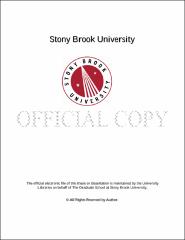| dc.identifier.uri | http://hdl.handle.net/11401/76329 | |
| dc.description.sponsorship | This work is sponsored by the Stony Brook University Graduate School in compliance with the requirements for completion of degree. | en_US |
| dc.format | Monograph | |
| dc.format.medium | Electronic Resource | en_US |
| dc.language.iso | en_US | |
| dc.publisher | The Graduate School, Stony Brook University: Stony Brook, NY. | |
| dc.type | Thesis | |
| dcterms.abstract | Because of the ultra-small size and biocompatibility of silver nanoclusters, they have attracted much research interest for their applications in biolabeling. Among the many ways of synthesizing silver nanoclusters, DNA templated method is particularly attractive--the high tunability of DNA sequences provides another degree of freedom for controlling the chemical and photophysical properties. However, systematic studies about how DNA sequences and concentrations are controlling the photophysical properties are still lacking. The aim of this thesis is to investigate the binding mechanisms of silver clusters binding and single stranded DNAs. Here in this thesis, we report synthesis and characterization of DNA-templated silver nanoclusters and provide a systematic interrogation of the effects of DNA concentrations and sequences, including lengths and secondary structures. We performed a series of syntheses utilizing five different sequences to explore the optimal synthesis condition. By characterizing samples with UV-vis and fluorescence spectroscopy, we achieved the most proper reactants ratio and synthesis conditions. Two of them were chosen for further concentration dependence studies and sequence dependence studies. We found that cytosine-rich sequences are more likely to produce silver nanoclusters with stronger fluorescence signals; however, sequences with hairpin secondary structures are more capable in stabilizing silver nanoclusters. In addition, the fluorescence peak emission intensities and wavelengths of the DNA templated silver clusters have sequence dependent fingerprints. This potentially can be applied to sequence sensing in the future. However all the current conclusions are not warranted; there is still difficulty in formulating general rules in DNA strand design and silver nanocluster production. Further investigation of more sequences could solve these questions in the future. | |
| dcterms.available | 2017-09-20T16:50:02Z | |
| dcterms.contributor | Nykypanchuk, Dmytro | en_US |
| dcterms.contributor | Su, Dong | en_US |
| dcterms.contributor | Sokolov, Jonathan. | en_US |
| dcterms.creator | Lin, Ruoqian | |
| dcterms.dateAccepted | 2017-09-20T16:50:02Z | |
| dcterms.dateSubmitted | 2017-09-20T16:50:02Z | |
| dcterms.description | Department of Materials Science and Engineering. | en_US |
| dcterms.extent | 62 pg. | en_US |
| dcterms.format | Application/PDF | en_US |
| dcterms.format | Monograph | |
| dcterms.identifier | http://hdl.handle.net/11401/76329 | |
| dcterms.issued | 2015-08-01 | |
| dcterms.language | en_US | |
| dcterms.provenance | Made available in DSpace on 2017-09-20T16:50:02Z (GMT). No. of bitstreams: 1
Lin_grad.sunysb_0771M_11916.pdf: 1371235 bytes, checksum: 7b9d67250f6682ebb0f5649d6eb966a6 (MD5)
Previous issue date: 2014 | en |
| dcterms.publisher | The Graduate School, Stony Brook University: Stony Brook, NY. | |
| dcterms.subject | Materials Science | |
| dcterms.title | Fluorescent DNA-templated silver nanoclusters | |
| dcterms.type | Thesis | |

